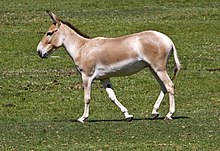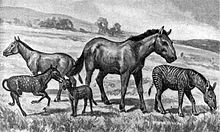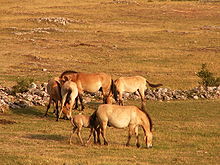Equidae
| Equidae | |
|---|---|

| |
| Persian onager | |
| Scientific classification | |
| Domain: | Eukaryota |
| Kingdom: | Animalia |
| Phylum: | Chordata |
| Class: | Mammalia |
| Order: | Perissodactyla |
| Suborder: | Hippomorpha |
| Family: | Equidae Gray, 1821 |
| Subfamilies | |
Equidae (sometimes known as the horse family) is the taxonomic family of horses and related animals, including the extant horses, asses, and zebras, and many other species known only from fossils. The family evolved around 50 million years ago from a small, multi-toed ungulate into larger, single-toed animals. All extant species are in the genus Equus, which originated in North America. Equidae belongs to the order Perissodactyla, which includes the extant tapirs and rhinoceros, and several extinct families.
The term equid refers to any member of this family, including any equine.
Evolution[edit]

The oldest known fossils assigned to Equidae were found in North America, and date from the early Eocene epoch, 54 million years ago. They were once assigned to the genus Hyracotherium, but the type species of that genus is now regarded as a palaeothere. The other species have been split off into different genera. These early equids were fox-sized animals with three toes on the hind feet, and four on the front feet. They were herbivorous browsers on relatively soft plants, and already adapted for running. The complexity of their brains suggest that they already were alert and intelligent animals.[2] Later species reduced the number of toes, and developed teeth more suited for grinding up grasses and other tough plant food.
The equids, like other perissodactyls, are hindgut fermenters. They have evolved specialized teeth that cut and shear tough plant matter to accommodate their fibrous diet.[3] Their seemingly inefficient digestion strategy is a result of their size at the time of its evolution,[4] as they would have already had to be relatively large mammals to be supported on such a strategy.
The family became relatively diverse during the Miocene epoch,[5] with many new species appearing. By this time, equids were more truly horse like, having developed the typical body shape of the modern animals.[6] Many of these species bore the main weight of their bodies on their central third toe, with the others becoming reduced and barely touching the ground, if at all. The sole surviving genus, Equus, had evolved by the early Pleistocene epoch, and spread rapidly through the world.[7]
Classification[edit]




- Order Perissodactyla (In addition to Equidae, Perissodactyla includes four species of tapir in a single genus, as well as five living species (belonging to four genera) of rhinoceros.) † indicates extinct taxa.
- Family Equidae
- Subfamily †Eohippinae
- Genus †Epihippus
- Genus †Haplohippus
- Genus †Eohippus
- Genus †Minippus[8]
- Subfamily †Propalaeotheriinae
- Genus †Orohippus
- Genus †Pliolophus
- Genus †Protorohippus
- Genus †Sifrhippus
- Genus †Xenicohippus[8]
- Genus †Eurohippus
- Genus †Propalaeotherium?[9]
- Subfamily †Anchitheriinae
- Genus †Anchitherium
- Genus †Archaeohippus
- Genus †Desmatippus
- Genus †Hypohippus
- Genus †Kalobatippus
- Genus †Megahippus
- Genus †Mesohippus
- Genus †Miohippus
- Genus †Parahippus
- Genus †Sinohippus
- Subfamily Equinae
- Genus †Merychippus
- Genus †Scaphohippus
- Genus †Acritohippus
- Tribe †Hipparionini
- Genus †Eurygnathohippus
- Genus †Hipparion
- Genus †Hippotherium
- Genus †Nannippus
- Genus †Neohipparion
- Genus †Proboscidipparion
- Genus †Pseudhipparion
- Tribe Equini
- Genus †Haringtonhippus[10]
- Genus †Heteropliohippus[11]
- Genus †Parapliohippus[11]
- Subtribe Protohippina
- Genus †Calippus
- Genus †Protohippus
- Subtribe Equina
- Genus †Astrohippus
- Genus †Dinohippus
- Genus Equus (22 species, 7 extant)
- Equus ferus Wild horse
- Equus ferus caballus Domestic horse
- †Equus ferus ferus Tarpan
- Equus ferus przewalskii Przewalski's horse
- †Equus algericus[12]
- †Equus alaskae
- †Equus lambei Yukon wild horse
- †Equus niobrarensis
- †Equus scotti
- †Equus conversidens Mexican horse
- †Equus semiplicatus
- Subgenus †Amerhippus (this subgenus and its species are possibly synonymous with E. ferus)[13]
- Subgenus Asinus
- Equus africanus African wild ass
- Equus africanus africanus Nubian wild ass
- Equus africanus asinus Domestic donkey
- †Equus africanus atlanticus Atlas wild ass
- Equus africanus somalicus Somali wild ass
- Equus hemionus Onager or Asiatic wild ass
- Equus hemionus hemionus Mongolian wild ass
- †Equus hemionus hemippus Syrian wild ass
- Equus hemionus khur Indian wild ass
- Equus hemionus kulan Turkmenian kulan
- Equus hemionus onager Persian onager
- Equus kiang Kiang
- Equus kiang chu Northern kiang
- Equus kiang kiang Western kiang
- Equus kiang holdereri Eastern kiang
- Equus kiang polyodon Southern kiang
- †Equus hydruntinus European ass
- †Equus altidens
- †Equus tabeti
- †Equus melkiensis
- †Equus graziosii
- Equus africanus African wild ass
- Subgenus Hippotigris[a]
- Equus grevyi Grévy's zebra
- †Equus koobiforensis
- †Equus oldowayensis
- Equus quagga Plains zebra
- Equus quagga boehmi Grant's zebra
- Equus quagga borensis Maneless zebra
- Equus quagga burchellii Burchell's zebra
- Equus quagga chapmani Chapman's zebra
- Equus quagga crawshayi Crawshay's zebra
- †Equus quagga quagga Quagga
- Equus quagga selousi Selous' zebra
- Equus zebra Mountain zebra
- Equus zebra hartmannae Hartmann's mountain zebra
- Equus zebra zebra Cape mountain zebra
- †Equus capensis
- †Equus mauritanicus
- Subgenus †Parastylidequus
- †Equus parastylidens Mooser's horse
- †Subgenus Sussemionus[16]
- incertae sedis
- †Equus simplicidens Hagerman horse
- †Equus cumminsii
- †Equus livenzovensis
- †Equus sanmeniensis
- †Equus teilhardi
- †Equus numidicus
- †Equus plicidens
- †Equus cedralensis
- †Equus stenonis group
- †subgenus Allozebra
- †Equus (A.) occidentalis western horse
- Equus ferus Wild horse
- †Equus (A.) excelsus
- Genus †Hippidion
- Genus †Onohippidium
- Genus †Pliohippus
- Subfamily †Eohippinae
- Family Equidae
Notes[edit]
References[edit]
- ^ "PBDB". paleobiodb.org. Retrieved 2021-07-18.
- ^ Palmer, D., ed. (1999). The Marshall Illustrated Encyclopedia of Dinosaurs and Prehistoric Animals. London: Marshall Editions. p. 255. ISBN 1-84028-152-9.
- ^ Engels, Sandra; Schultz, Julia A. (June 2019). "Evolution of the power stroke in early Equoidea (Perissodactyla, Mammalia)". Palaeobiodiversity and Palaeoenvironments. 99 (2): 271–291. Bibcode:2019PdPe...99..271E. doi:10.1007/s12549-018-0341-4. ISSN 1867-1594. S2CID 133808650.
- ^ Janis, Christine (1976). "The Evolutionary Strategy of the Equidae and the Origins of Rumen and Cecal Digestion". Evolution. 30 (4): 757–774. doi:10.1111/j.1558-5646.1976.tb00957.x. ISSN 1558-5646. PMID 28563331. S2CID 5053639.
- ^ Cantalapiedra, Juan L.; Sanisdro, Oscar L.; Cantero, Enrique; Prado, Jose Luis; Alberdi, Mª Teresa Luis (4 August 2023). "Evolutionary Radiation of Equids". In Prins, Herbert H.; Gordon, Ian J. (eds.). The Equids, A Suite of Splendid Species. Fascinating Life Sciences. Springer. pp. 27–45. doi:10.1007/978-3-031-27144-1_2. ISBN 978-3-031-27143-4 – via www.springer.com.
- ^ MacFadden, B. J. (March 18, 2005). "Fossil Horses--Evidence for Evolution" (PDF). Science. 307 (5716): 1728–1730. doi:10.1126/science.1105458. PMID 15774746. S2CID 19876380.
- ^ Savage, RJG & Long, MR (1986). Mammal Evolution: an illustrated guide. New York: Facts on File. pp. 200–204. ISBN 0-8160-1194-X.
- ^ a b Froehlich, D.J. (February 2002). "Quo vadis eohippus? The systematics and taxonomy of the early Eocene equids (Perissodactyla)". Zoological Journal of the Linnean Society. 134 (2): 141–256. doi:10.1046/j.1096-3642.2002.00005.x.
- ^ Remy, Jean A.; Krasovec, Gabriel; Marandat, Bernard (2016). "A new species of Propalaeotherium (Palaeotheriidae, Perissodactyla, Mammalia) from the Middle Eocene locality of Aumelas (Hérault, France)". Palaeovertebrata. 40 (2): e1. doi:10.18563/pv.40.2.e1.
- ^ Hay, Oliver P. (1915). "Contributions to the Knowledge of the Mammals of the Pleistocene of North America". Proceedings of the United States National Museum. 48 (2086): 535–549. doi:10.5479/si.00963801.48-2086.515
- ^ a b Bravo-Cuevas, V.M.; Ferrusquía-Villafranca, I. (2010). "The oldest record of Equini (Mammalia: Equidae) from Mexico" (PDF). Revista Mexicana de Ciencias Geológicas. 27 (3): 593–603. Retrieved 14 August 2020.
- ^ Aouraghe, Hassan; et al. (1999). "Les équidés du Pléstocène supérior de la grotte Zouhrah à El Harhoura, Maroc". Quaternaire (in French). 10: 283–292. doi:10.3406/quate.1999.1649.
- ^ Orlando, L.; et al. (2008). "Ancient DNA Clarifies the Evolutionary History of American Late Pleistocene Equids". Journal of Molecular Evolution. 66 (5): 533–538. Bibcode:2008JMolE..66..533O. doi:10.1007/s00239-008-9100-x. PMID 18398561. S2CID 19069554.
- ^ Vilstrup, Julia T.; et al. (2013). "Mitochondrial Phylogenomics of Modern and Ancient Equids". PLOS ONE. 8 (2): e55950. Bibcode:2013PLoSO...855950V. doi:10.1371/journal.pone.0055950. PMC 3577844. PMID 23437078.
- ^ Groves, C. P.; Bell, C. H. (2004). "New investigations on the taxonomy of the zebras genus Equus, subgenus Hippotigris". Mammalian Biology. 69 (3): 182–196. doi:10.1078/1616-5047-00133.
- ^ Eisenmann, Vera (March 2010). "Sussemionus, a new subgenus of Equus (Perissodactyla, Mammalia)". Comptes Rendus Biologies. 333 (3): 235–240. doi:10.1016/j.crvi.2009.12.013. PMID 20338542.
- ^ Eisenmann, Vera; Vasilijiev, Sergej (September 2011). "Unexpected finding of a new Equus species (Mammalia, Perissodactyla) belonging to a supposedly extinct subgenus in late Pleistocene deposits of Khakassia (Southwestern Siberia)". Geodiversitas. 33 (3): 519–530. doi:10.5252/g2011n3a5. S2CID 128625427.
- ^ "Fossilworks: Equus fraternus". fossilworks.org. Retrieved 17 December 2021.
